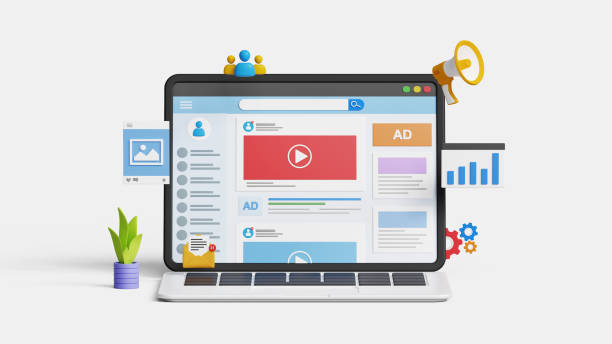Introduction to Secure Website Design and Its Importance in the Digital Age

In today’s world, an online presence is of paramount importance for every business and even individual.
Websites are not just showcases for businesses, but also places for interaction, transactions, and storage of sensitive information.
In this context, #secure website design# is not an option, but an undeniable necessity.
Website security not only protects user and business information but also directly impacts user credibility and trust.
A secure website provides a reliable platform for online activities and prevents financial and reputational damages resulting from cyberattacks.
This section covers the explanatory and educational aspects of the fundamental importance of web security.
Lack of security can lead to data loss, data corruption, identity theft, and even complete cessation of online activities.
Therefore, any investment in cybersecurity and secure website design is, in fact, an investment in the future and sustainability of the business.
Paying attention to security details from the very initial stages of development ensures the website’s resilience against growing threats.
This perspective should be an integral part of every developer’s and website owner’s philosophy.
Are you worried your company’s old website is driving away new customers? Rasaweb solves this problem with modern and efficient corporate website design.
✅ Increases your brand’s credibility.
✅ Helps attract targeted customers.
⚡ Contact Rasaweb for a free consultation!
Key Principles of Secure Website Design and Defensive Architecture

To create a website resistant to attacks, adherence to key principles in architecture and implementation is crucial.
These principles serve as the backbone of secure website design and include concepts such as “Security by Design”, the Principle of Least Privilege, and Defense in Depth.
Security by Design means that security considerations should be integral from the very early stages of the website design phase, not as an add-on feature.
This specialized and guiding approach helps prevent vulnerabilities before they even form.
The Principle of Least Privilege states that every user, process, or system should only have access to the minimum resources and permissions required to perform its tasks.
This minimizes the risk of unauthorized access abuse.
Defense in Depth also involves using multiple layers of security; so that if one layer is breached, subsequent layers can protect the system.
This includes firewalls, Intrusion Detection Systems (IDS), encryption, and precise access control.
Implementing these principles provides a strong infrastructure for web security and makes any attempt at penetration more difficult.
In fact, a secure website design without attention to these principles is like building a house without a solid foundation that collapses at the first storm.
Common Web Vulnerabilities and Countermeasures

Understanding common web vulnerabilities is the first step in secure website design and building resilient websites.
This section analytically and provocatively examines some of the most common threats and provides countermeasures.
These vulnerabilities include SQL Injection, Cross-Site Scripting (XSS), and Cross-Site Request Forgery (CSRF).
SQL Injection occurs when an attacker attempts to access or modify database data by inserting malicious code into input fields.
To counter this, using Prepared Statements and rigorous input validation is essential.
XSS allows an attacker to inject malicious scripts into web pages and steal user information; its solution involves filtering and escaping inputs and outputs.
CSRF enables an attacker to perform unwanted operations on behalf of an authenticated user and can be prevented by using CSRF tokens.
Secure website design requires full awareness of these vulnerabilities and continuous application of best practices to repel them.
Web vulnerabilities are constantly changing and evolving, requiring continuous updates in security knowledge and tools.
Table 1: Common Web Vulnerabilities and Prevention Methods
| Vulnerability | Description | Prevention Methods |
|---|---|---|
| SQL Injection | Injecting malicious SQL codes to access or modify database data. | Using Prepared Statements, input validation, using ORM. |
| Cross-Site Scripting (XSS) | Injecting malicious script codes into web pages that are executed by the user’s browser. | Validating and filtering outputs (Output Encoding), Content Security Policy (CSP). |
| Cross-Site Request Forgery (CSRF) | Executing unwanted operations on behalf of an authenticated user. | Using CSRF tokens, checking Origin Header. |
| Broken Authentication | Weaknesses in authentication mechanisms that allow unauthorized access. | Implementing strong password policies, Multi-Factor Authentication (MFA), secure session management. |
The Role of SSL/TLS Certificates and Secure Communications

One of the most important pillars of secure website design is encrypting communications between the server and the user’s browser.
This is achieved through SSL/TLS (Secure Sockets Layer/Transport Layer Security) certificates.
An SSL/TLS certificate not only encrypts exchanged information to prevent eavesdropping or tampering but also verifies the server’s identity, assuring users they are communicating with a legitimate website.
Using HTTPS instead of HTTP is a clear sign of a secure website and is also recognized as an important factor in search engine rankings.
In this explanatory and technical section, we discuss the importance and functionality of these certificates.
Proper SSL/TLS installation, regular certificate updates, and ensuring secure server configurations (such as using TLS 1.2 or higher protocols and strong cipher suites) are vital for maintaining security.
These certificates protect sensitive data like bank card information, passwords, and personal details against Man-in-the-Middle attacks.
Therefore, every secure website design must include a comprehensive strategy for communication encryption.
Failure to use SSL/TLS can lead to security warnings in browsers, deterring users from visiting your website and damaging your credibility.
Are you frustrated with your online store’s low conversion rate?
Rasaweb, with its professional e-commerce website design, is your definitive solution!
✅ Increase your sales and revenue
✅ Unparalleled user experience for your customers
⚡ Get a free consultation now!
Secure Authentication and Access Management Methods

Authentication and access management are crucial components in secure website design.
This section guides and specializes in examining best practices to ensure that only authorized users can access the system and only to the resources they are permitted.
These measures include using strong and unique passwords, implementing two-factor (MFA) or multi-factor authentication mechanisms, and utilizing secure tokens for Session Management.
Password policies should include requirements for a combination of uppercase and lowercase letters, numbers, and symbols, and a specified minimum length.
MFA provides an additional layer of security, making unauthorized access difficult even if a password is compromised.
Secure session management involves generating strong session tokens, regularly expiring sessions, and preventing Session Hijacking attacks.
Furthermore, implementing Role-Based Access Control (RBAC) ensures that each user only accesses the parts of the website or system necessary for their role.
This approach helps reduce the potential attack surface and prevents unnecessary access.
A secure website design that adheres to these principles can provide greater assurance for both users and website administrators.
Backend and Database Security in Development

Backend and database security are considered main pillars of secure website design, as these sections are where sensitive information is stored and processed.
This part analytically and technically addresses the importance and solutions for protecting these components.
Encrypting data at rest and in transit, using Web Application Firewalls (WAFs), proper error and log management, and regular updates of server and database software are among the vital measures.
Furthermore, ensuring that APIs are securely designed and only provide necessary information to authorized requestors is essential.
Using secure protocols for internal communications between services and modules is also highly important.
Regarding the database, in addition to preventing SQL injection, special attention should be paid to access management at the database level, deleting unnecessary information, and regular, secure data backups.
Implementing a secure website requires a comprehensive approach that covers both front-end and back-end.
Information leaks from a database can be catastrophic, so every aspect of database security must be carefully considered.
Database security includes not only technology but also security processes and developer team training.
Client-Side (Front-End) Security Considerations and Browser Protection

While backend security is vital, secure website design cannot be complete without addressing client-side or front-end security considerations.
This section educates and guides on security aspects directly dealing with the user’s browser.
Attacks like XSS, mentioned earlier, directly exploit front-end vulnerabilities.
For protection, user inputs must be carefully validated and filtered, and Output Encoding techniques should be used for displaying data to prevent malicious code execution.
Using a Content Security Policy (CSP) is another important security layer that tells the browser which resources (scripts, styles, images, etc.) can be loaded and executed, preventing code injection attacks.
Additionally, awareness of vulnerabilities in old or vulnerable JavaScript libraries and frameworks is crucial, and they should be regularly updated.
Cookies and localStorage should also be managed securely, for example, by setting the HttpOnly flag for cookies to prevent JavaScript access to them.
Secure website design on the front-end means defensive coding and awareness of the potential for attacks through the user’s browser.
Table 2: Best Practices for Client-Side (Front-End) Security
| Security Aspect | Description | Recommended Actions |
|---|---|---|
| Input and Output Validation | Ensuring that input data is secure and outputs are correctly filtered. | Using Input Validation and Output Encoding to prevent XSS. |
| Content Security Policy (CSP) | Informing the browser about authorized resources for loading. | Careful configuration of CSP headers to restrict resources and prevent script injection. |
| Secure Cookie Management | Protecting cookies from unauthorized access. | Using Secure, HttpOnly, and SameSite flags for cookies. |
| Updating Libraries and Frameworks | Using up-to-date versions without known vulnerabilities. | Regular monitoring of vulnerabilities in used libraries and timely updates. |
The Importance of Penetration Testing, Security Audits, and Continuous Updates

Secure website design is an ongoing process, not a one-time action.
After implementation, regular Penetration Testing and security audits are crucial to identify vulnerabilities before attackers discover them.
This section reports and specializes in the importance of these activities.
Penetration testing simulates real attacks performed by security professionals to find weaknesses in the system.
Reports from these tests help developers fix weaknesses and strengthen the website.
In addition to penetration testing, regular Security Audits and continuous security monitoring are also essential for real-time threat detection.
Continuous updates of server software, operating systems, frameworks, and libraries used are another important defensive layer.
Many cyberattacks exploit known vulnerabilities in older software versions.
Development teams must stay informed about the latest security news and apply security patches promptly.
This proactive approach is an integral part of a comprehensive secure website design strategy that helps protect businesses and users against emerging threats.
Research shows that 80% of customers trust companies with a professional website more. Does your current website inspire this trust?
With Rasaweb’s corporate website design services, permanently solve the problem of customer distrust and a weak online image!
✅ Create a professional image and increase customer trust
✅ Attract more sales leads and grow your business
⚡ Get a free consultation
Incident Response and Disaster Recovery Planning

Even with the best secure website design and preventive measures, the probability of a security incident never reaches zero.
Therefore, having a comprehensive plan for Incident Response and Disaster Recovery is of paramount importance.
This section guides and specializes in how to prepare for such events.
The incident response plan should include specific steps for identification, containment, eradication, recovery, and lessons learned.
Defining roles and responsibilities within the team, monitoring and alert tools, and communication channels for informing stakeholders (including users if necessary) are key components of this plan.
The disaster recovery plan also includes strategies for quick and complete recovery of systems and data after a serious attack or failure.
This involves regular and encrypted data backups, testing recovery plans, and having alternative infrastructures to quickly relaunch the website in case of a problem.
A secure website design, in addition to prevention, must also include preparedness for worst-case scenarios to minimize potential damage and allow the website to quickly return to normal operation.
Recovery planning is essential for any business that relies on its online presence.
Future Trends in Web Security and the Necessity of Continuous Learning

The world of cybersecurity is constantly changing and evolving, and with the emergence of new technologies, threats and attacks become more sophisticated.
Therefore, secure website design requires an approach based on continuous learning and adaptability to future trends.
This section analytically and engagingly addresses some of the emerging trends and future challenges in web security.
Artificial intelligence and machine learning are not only used to strengthen security defenses (such as intelligent intrusion detection systems) but are also employed by attackers to automate complex attacks.
API security has gained increasing importance with the growing use of microservices and single-page applications (SPAs).
Blockchain technology and its applications in increasing data transparency and security are also being explored.
Furthermore, the rise of more sophisticated phishing attacks and social engineering has doubled the need for user education and increased security awareness.
To maintain a secure website in the future, developers and security specialists must always be learning the latest standards, vulnerabilities, and new tools.
This dynamic and forward-thinking approach ensures that your website remains resilient against new threats and retains user trust.
Web security is an endless journey, not a destination.
Frequently Asked Questions
| Question | Answer |
|---|---|
| What is secure website design? | Secure website design is a process in which websites are built with security principles in mind to be resilient against cyberattacks and to protect user and business information. |
| Why is secure website design of high importance? | To prevent unauthorized data access, sensitive information leaks, malware attacks, loss of user trust, damage to business reputation, and legal consequences resulting from data breaches. |
| What are the most common website vulnerabilities? | SQL Injection, Cross-Site Scripting (XSS), Cross-Site Request Forgery (CSRF), broken authentication and session management, and sensitive data exposure. |
| How can SQL Injection attacks be prevented? | Using Prepared Statements with parameterized queries, Input Validation, and restricting database access. |
| What are the methods to counter XSS (Cross-Site Scripting) attacks? | User input validation, Output Encoding before displaying in HTML, and using a Content Security Policy (CSP). |
| What is the role of HTTPS in website security? | HTTPS encrypts the communication between the user’s browser and the website server using an SSL/TLS certificate, preventing eavesdropping, tampering, or forging of data. |
| What are the best practices for user password management? | Enforcing strong passwords (a combination of letters, numbers, and symbols), hashing passwords instead of direct storage (with strong algorithms like bcrypt), and enabling Two-Factor Authentication (2FA). |
| What is the importance of User Input Validation? | Input validation prevents malicious or unexpected data from entering the system, which can lead to vulnerabilities such as SQL Injection or XSS. |
| What impact do regular security reviews and audits have on site security? | These reviews help identify vulnerabilities and security weaknesses early, allowing them to be fixed before they can be exploited. |
| What is the use of Web Application Firewall (WAF) in secure website design? | A WAF acts as a protective layer between the user and the website, analyzing incoming traffic, identifying, and blocking common web attacks like SQL Injection and XSS. |
And other services of Rasaweb Advertising Agency in the field of advertising
Smart Google Ads: A fast and efficient solution to increase click-through rates with a focus on using real data.
Smart Website Development: A fast and efficient solution to increase website traffic with a focus on intelligent data analysis.
Smart Digital Advertising: A novel service to increase customer acquisition through the use of real data.
Smart Data Analysis: Professional optimization for campaign management using attractive user interface design.
Smart Sales Automation: A fast and efficient solution for online growth with a focus on marketing automation.
And over hundreds of other services in the field of internet advertising, advertising consultation, and organizational solutions
Internet Advertising | Advertising Strategy | Advertorials
Resources
Website Security Checklist
Security in Website Design
Digital Business Success Factors
Secure Website Design
? Are you ready to transform your business in the digital world? Rasaweb Afarin Digital Marketing Agency, by providing professional services including WordPress website design and SEO optimization, paves your path to online success. Build a bright future for your brand with us.
📍 Tehran, Mirdamad Street, next to Bank Markazi, Southern Kazeroon Alley, Ramin Alley, No. 6




